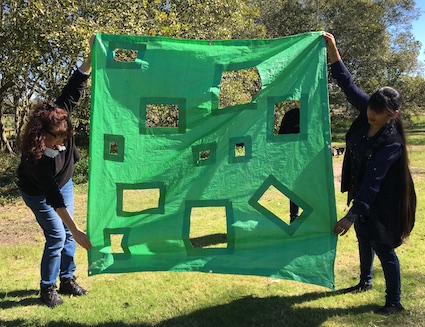
Do you have an old worn out tarp tucked away in a cupboard or shed, collecting dust and guilt? I never liked to throw away a tarp as it’s a sheet of plastic and will take a long time to rot in a landfill site. When I was writing the draft of my Messy Maths book, I realised the old tarps were ripe and ready for a mathematical makeover…
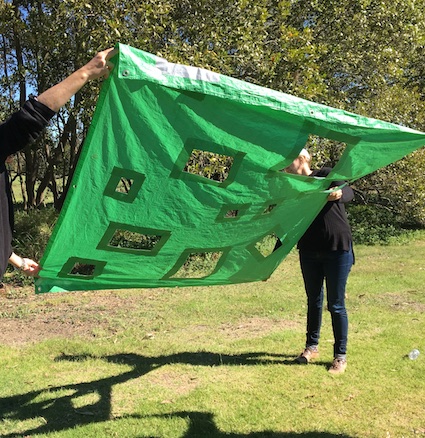
The concept is simple and the process too:
- Find some objects, place them on your tarp. Put these over any holes, rips or worn patches.
- Draw around them with a marker pen.
- Put duck tape along the lines you have drawn to outline the shapes. You only need to do this on one side.
- Cut out the shape, taking care not to cut into the duct tape. By adding duct tape first, you are not left with sticky edges 🙂
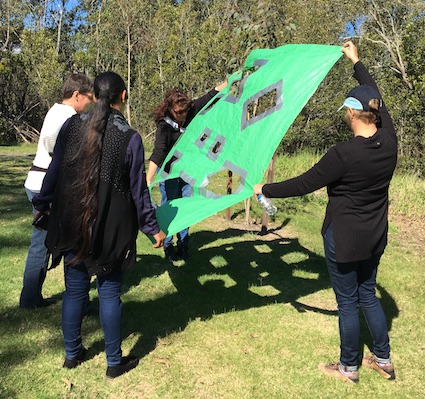
The result is a lot of fun as both course participants and children realised as I took the tarp with me on my travels. I very deliberately stuck to using rectangles and used boxes and books that were available in my dining room to create the variety you can see in this tarp. If you look carefully you will find the following:
- Most, but not all the rectangles are part of a pair. Interestingly no child or adult spotted this.
- Some of the rectangles demonstrate rotation but most have been translated when you look at the placement of pairs in relation to each other. They demonstrate congruence.
- All the shapes are rectangles. They may be different sizes and proportions but they are still rectangles. For young children this can be helpful to see a range and learn what makes a rectangle a rectangle – the specific properties. This is shows the geometric principle of family likeness.
- When you bend or move the tarp, the rectangles undergo a topological transformation and become distorted. This is why we can wear the tarp as a mathematical cape 🙂
Now, that I’ve explained the mathematical reasoning behind my tarp, common sense says, you have complete freedom and flexibility to create any shapes of any size on any part of a tarp:
If the children you work with are up for it, they can choose objects to draw around – it may be an eclectic collection but the talk that will be generated will be mathematical as they notice the attributes of the objects. They may prefer to use a standard collection of 2D shapes to draw around. You can decide if you want tarps of different shapes such as squares, quadrilaterals, circles, triangles and so on.
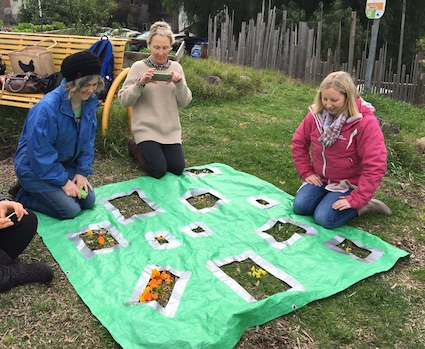
The maths activities that this tarp has generated have been considerable. Rather than creating activities and showing children and course participants what to do, we’ve brainstormed possibilities. In the photo above, the participants used the tarp as a sorting sheet. In another photo you will see that a group are exploring how the angle of the tarp in relation to the sun affects the shadow pattern created (a topological transformation).
Now this tarp really lends itself to free play. It does not need to have adult input. All the play has lots of mathematical value. The trick is to be aware of how the placement of a tarp will affect the possibilities that exist:
- Hang the tarp vertically – watch and see what children do. Will they climb through some of the squares? Do they use it for target practice? Or simply as frames where they look through and someone else takes their photo?
- Add the tarp to a den building kit. It may be used to create window panels. Or the children may decide to wear it as a cloak.
- Hang the tarp up high, horizontally. Now what will children do? Do they explore the shadows created underneath? Or do they try and throw sticks or balls up and through the rectangles? Perhaps they prefer to lob these items from afar and find out which land on top of the tarp.
- Leave the tarp on the ground. Will children step on the rectangles? Do they decide to have a picnic there? A child might decide to make it into a raceway for toy cars.
The play possibilities are infinite and limited only by our imagination.
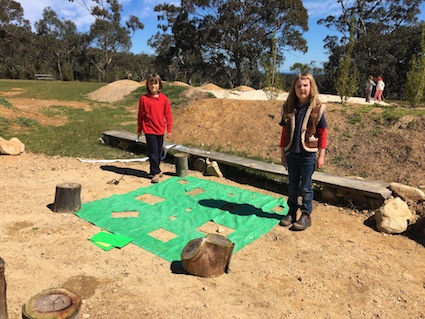
I also found that children built upon each others ideas. In the photo above, two Australian children created a target board. Beside each rectangle they placed numbers. Stones were thrown onto the tarp from around its edges. Two weeks later in a Hong Kong school, the class decided to play a stick rolling game. They sat around the edge of the tarp and rolled the 10cm cut sticks onto the tarp. They used the numbers provided by the previous users for mental addition.
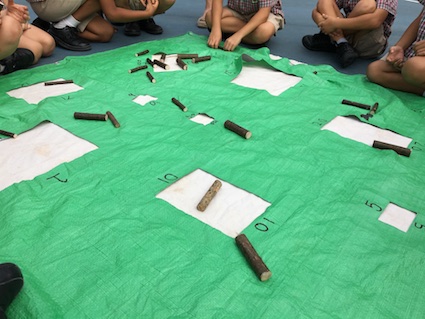
So, dig out those worn tarps and get creating. Maths is playful. Maths is fun. Maths is practical. Maths is a repurposed tarp…!
This is an updated version of a post first published in January 2017. The original tarp shown in these photos continued to be used by me up until I retired, and I still have it! The duct tape did start to peel away and I replaced this with more – simply to allow children the freedom to use the gaps without worrying about rips and tears. The tarp can also be repurposed in other ways as shown in this blog post.




















Happy New Year Juliet from the Yorkshire Coast. As always your site gives me great inspiration and ideas. Thank you so much, a lot of children benefit from you and others who contribute. I can’t wait to start on my tarp and saw down my Christmas tree which is waiting in the garden for further events! There is the tractor tyre on the beach too, awaiting a trailer to transport it to my Thursday school!!!
Thank you so much, a lot of children benefit from you and others who contribute.
Rosalyn Boyes
Thanks for your kind words, Rosalyn – I hope you are keeping well. Lucky children in your Thursday school!
Juliet, I really appreciate the element of play given over to the children you added to the math tarp. Too often as educators we get locked into our “math’ agenda. Allowing the children to create often makes the math richer. Tom
Yes – starting from where children are at is so much more enabling… you do realise this is inspired by your work… look at the levels and inclines… just saying… 🙂
Yes, I did think I saw a little bit of my work there, but you do so much more with it. Just saying.
Here here!